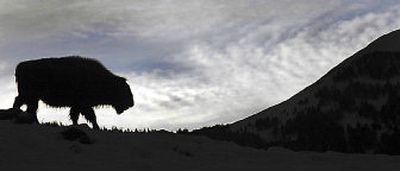Salish, Kootenai plan winter bison hunt

BOZEMAN – Members of the Confederated Salish and Kootenai Tribes plan to hunt bison near Yellowstone National Park this winter, which is legal under a 19th-century treaty, state officials said.
Tribal members also will have the option of shooting elk, bighorn sheep or other species, and state hunting licenses or permits won’t be necessary, said Sam Sheppard, Montana Department of Fish, Wildlife and Parks warden captain in Bozeman.
“If they have the right, they have the right,” Bob Lane, staff attorney for the department, told the Bozeman Daily Chronicle.
The tribe is still working out how many tags it will issue to members. The decision rests with tribal council members, Sheppard said, but “they’re very willing to work with us.”
Tribal spokesman Rob McDonald said he expects that no more than a handful of animals of any species will be taken.
“It’s going to be a very limited hunt,” McDonald said. “It’s going to be cultural, and we’re trying to optimize the kind of teaching that could be done.”
McDonald said he envisions something similar to a hunt Idaho’s Nez Perce tribe held last winter, when youths from the tribe went to the area and shot five or six bison under the guidance of elders.
Since the hunt takes place under treaty rights, tribal members don’t have to follow some state laws.
For instance, they don’t have to wear hunter orange, and they don’t have to comply with state shooting hours. They do, however, have to follow tribal rules, which prohibit the use of artificial light.
The tribe’s rights were granted under “Stevens language,” which allows members of some tribes to hunt on their traditional grounds. American Indian hunters on their way to the park would be free to shoot deer, elk, bighorn or other species “incidental” to the bison hunt, Sheppard said.
They cannot hunt inside Yellowstone.
The hunting must be confined to “unclaimed” federal land, which is defined as national forest or Bureau of Land Management property.
“They have no treaty rights on private property,” Sheppard said.
A number of tribes claim ancestral hunting rights in the Yellowstone area.
But FWP does not recognize all such claims, some of which are spelled out in treaties with less specific language about where members can hunt.
In related news, two bison were killed Wednesday on the first day of Montana’s 2006-07 hunt for bison that wander out of Yellowstone National Park, the state wildlife agency said.
Opening day was quiet compared with the start of bison season in 2005, when Montana held its first bison hunt in 15 years, and state officials braced for protests and media attention was high.
Buffalo Field Campaign co-founder Mike Mease said that the bison advocacy group is “not here to harass hunters. We’re hoping for some sort of dialogue.” Mease spoke in a campground parking lot near the place where a bison was shot Wednesday.
The state Fish, Wildlife and Parks Commission has described the hunt, which ends Feb. 15, as a tool to help manage bison.